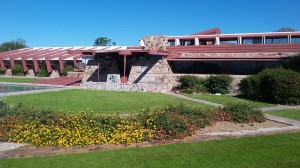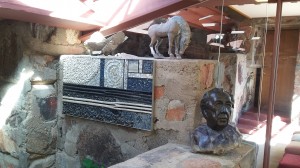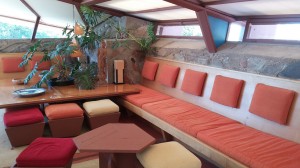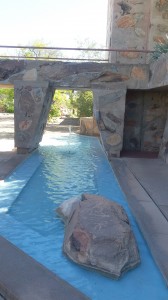A VISIT TO WESTERN ARIZONA – FRANK LLOYD WRIGHT’S TALIESIN WEST
A VISIT TO WESTERN ARIZONA
This is the second in a series of articles about visiting Western Arizona
FRANK LLOYD WRIGHT’S TALIESIN WEST
By Charles N. Stevens
Photos by Dolores Seidman
On the outskirts of Phoenix, located on five hundred acres of Sonoran Desert is Taliesin West, a complex designed by architect Frank Lloyd Wright, and devoted to modern architecture. The great architect established it as his winter camp, away from the bitter cold and snow of the Midwest. Wright wintered here from 1937 until 1959, the year of his death at 91.
Our bus rolled up to Taliesin West in the morning, the sun brilliant on the rock walls and low forms of the buildings. Frank Lloyd Wright was a firm believer in blending buildings into the land forms upon which they were built. Before we entered the complex, I looked around at the landscape. In one direction rose the foothills of the McDowell Mountains, but in the opposite direction a gentle slope led down to the flatness of the desert plain. All around were the typical desert plants, the creosote bush, ocotillo, and cholla cactus. I found out that the rock walls I was looking at were constructed of desert rock, their interiors filled with boulders and concrete.
We began our tour of the complex at Wright’s living room. I sat in a most comfortable chair, actually designed by him, listening to the words of our guide and gazing at the interior of the room. Some people sat in chairs just like mine while others sat on a long bench-like couch along the wall with permanent cushions built into the wall for back rests. The room was built to accommodate many guests. Natural light flowed into the room from above through translucent white plastic and from the slanted windows along one side. The ceiling beams angled upward as though they reached for the sky, much like the natural desert forms in the area. Like all the buildings on the campus, it had a low profile, blending as much as possible with the desert around it.
Next we walked into what was, at one time, Frank Lloyd Wright’s office. The room was smaller than the last, but built in the same general style, making good use of natural light. The actual desk he used, near the entrance, was still used by others. I imagined him sitting there, working on a new concept.
We moved on to the Sunset Terrace, a series of wide red rock stair steps with lawn and a large pool in front of it. From here we had a good view of the complex and the desert around it. I noticed especially the nearby tall rounded mountain top that appears to look down on Taliesin West. I should mention that the space in between buildings is generally filled with gardens, slow-moving streams, pools or fountains, all adding a relaxing beauty to the campus.
Next on our tour was the movie theater, the seating stair stepped for better viewing. Last on our tour were the drafting studios where students worked at their desks and drafting boards on architectural projects. No one was working as we walked through as it was a day off for them, but we could see the environment where they worked and learned. Again, the studios made great use of natural light.
Taliesin West is like a self-contained city with its many functions. It contains apartments for the students and staff, a swimming pool, kitchen, dining room, library, conference rooms, visitor’s center and pavilion.
Frank Lloyd Wright considered architecture more than just building things. There was a spiritual element to his work. He once said, “These buildings were wrested by his tireless energy from the earth and erected in the eye of the sun. It was originally the conscious creation out of man himself, of a higher self. His building, in order to be architecture, was the true spirit of himself made manifest.”
We left Taliesin West and were on our way to eventually see the famous Biltmore Hotel on the outskirts of Phoenix, also designed by Frank Lloyd Wright. We were looking forward to an arranged dinner here as well as looking at the architecture. The first problem was that by the time we arrived at the hotel, the sun had set and the hotel was shadowed. We saw just enough of the lines to recognize the work of the great architect. Inside we basked in the light of chandeliers in the long majestic lobby. We then had a tour of the hotel led by a man who unfortunately spoke with a French accent so pronounced that we could hardly understand him. But we could certainly enjoy what we were seeing. The dinner that we had looked forward to was sadly disappointing, but the restaurant itself was spectacular.
The day had been long, but interesting, but we were all ready for the ride back to our hotel rooms.

Looking at Taliesin West from the outside, one can see that the low buildings blend in with the desert.

A room containing the bust of Frank Lloyd Wright

The spacious living room where chairs and long couches accommodate large groups

Gardens and flowing water like this occupy the space between buildings
MONTEREY PARK AUTHOR PUBLISHES 4th BOOK – Seeking More of the Sky: Growing Up in the 1930’s:
Charles “Norm” Stevens, a 43 year resident of Monterey Park has recently published his 4th book: Seeking More of the Sky: Growing Up in the 1930’s. This is the story of a young boy growing up in Inglewood, California in the l930’s. This was a time during the depression when unemployment was affecting many and the banks were closed, while the clouds of war were gathering in Europe. But he was lucky enough to be raised in a loving family, the power of that love reflected throughout his stories.
Stevens is the author of three previous books about his experiences during WWII:
An Innocent at Polebrook: A Memoir of an 8th Air Force Bombardier (Story of his 34 bombing missions from his base at Polebrook, England over Germany and France)
The Innocent Cadet: Becoming A World War II Bombardier (A prequel to the first, telling of his training in the U.S. before going overseas into combat.)
Back from Combat: A WWII Bombardier Faces His Military Future from Combat: (This book details the time from when he returned from combat in England until the end of the war.)
He is known to the readers of The Citizen’s Voice as the author of Travel Log Articles including “Cruising the Rhine and Mosel”,” Best of the West”, “In Search of Snow” , “From Paris to Normandy on the Seine”, and “Exploring New York”. He is retired, having taught for 32 years, primarily in the Montebello Unified School District.
Those interested in purchasing an autographed copy of any of his books, may contact the author at 323-721-8230 or Normstevens24@gmail.com.



